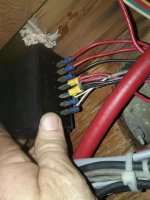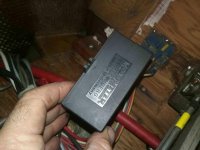realcaptron
Regular Contributor
Friends, I have encountered a new problem with my recently installed delco est's. Last week, I was fine tuning the carb adjustments at idle and when done with that, I decided to check once more the base timing and total advance for the heck of it.
I have timed these engines several times since installing a couple months ago and following the same procedure, this is what happened.....engine idling, hook up timing light, insert timing shunt into the distributor, connect shunt lead to battery positive....as soon as I touched the battery, the engine died AND I HAVE HAD NO IGNITION SINCE!. I have read the choke leads and the ignition coil with the ignition switch in "on" position (buzzer going off) and there is NO voltage at all to coil or choke....obviously I don't have any spark to start the motor. It just cranks.
So....please guide me..what happened? This is an old boat 1976 Crusader with old technology. There is an engine wiring harness but no reset or any other fuse or transistors that I can find. I don't understand why ignition switch is sending signal to buzzer and to starter solenoid but nothing to coil or choke positives.
On guy mentioned that some of the older harnesses had internal resistors that he thinks may have fried. I am asking your opinions and also what do you think would happen if I bypassed the 12v return wire from ignition straight to the coil and choke leads? If I am thereby supplying 12v to the coil yet still using the ignition key for cranking, would I damage anything or would it be ok to do this? Reason I want to do that is simply to verify that the engine itself will start and run, then go back to tracing the root cause.
I did swap the coil and ignition module from non running engine to running engine and no change. The running engine still starts and the non running one did not, so I am ruling out coil or module. Help please!
I have timed these engines several times since installing a couple months ago and following the same procedure, this is what happened.....engine idling, hook up timing light, insert timing shunt into the distributor, connect shunt lead to battery positive....as soon as I touched the battery, the engine died AND I HAVE HAD NO IGNITION SINCE!. I have read the choke leads and the ignition coil with the ignition switch in "on" position (buzzer going off) and there is NO voltage at all to coil or choke....obviously I don't have any spark to start the motor. It just cranks.
So....please guide me..what happened? This is an old boat 1976 Crusader with old technology. There is an engine wiring harness but no reset or any other fuse or transistors that I can find. I don't understand why ignition switch is sending signal to buzzer and to starter solenoid but nothing to coil or choke positives.
On guy mentioned that some of the older harnesses had internal resistors that he thinks may have fried. I am asking your opinions and also what do you think would happen if I bypassed the 12v return wire from ignition straight to the coil and choke leads? If I am thereby supplying 12v to the coil yet still using the ignition key for cranking, would I damage anything or would it be ok to do this? Reason I want to do that is simply to verify that the engine itself will start and run, then go back to tracing the root cause.
I did swap the coil and ignition module from non running engine to running engine and no change. The running engine still starts and the non running one did not, so I am ruling out coil or module. Help please!



